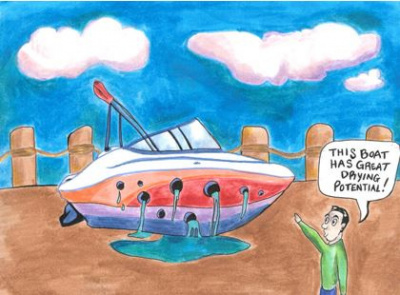
Unlike boats, a building’s walls must have some capability to “breathe” instead of being totally impervious to all forms of water. However, a misguided reliance on “breathing” or drying potential as the primary means to make a building’s wall work, without proper consideration of variations in conditions of use, can lead to the problem of wetting potential being too high when conditions of use change.
What you end up with is a wall that dries fast in one condition of use and then wets just as fast in another condition of use – just like the boat in the cartoon. Water or water vapor that leaves in one direction can also enter in the opposite direction when conditions change. For the boat illustration, the rate and direction of water movement depends on the size of the hole and the water pressure difference (which changes depending on whether the boat is in the water or dry-docked - see video below for a humorous take on a holey boat). Similarly, water vapor movement depends on the vapor permeability of material layers and the vapor pressure difference across those layers (which changes direction seasonally).
Because walls in buildings dry by means of water vapor movement, use of a high vapor permeance water-resistive barrier layer on the outside of the wall is often considered to be universally good. In some circumstances this may be true and is helpful. In many others, it is not. The problem is that vapor drives are not always in the outward direction. In fact, they are often in an inward direction. Furthermore, just focusing the vapor permeance of one layer does not fully address how the assembly will behave under changing circumstances.
The direction and amount of water vapor movement into or out of the wall depends on the time of year, the climate, the indoor conditions (temperature and relative humidity), the vapor permeance of the material layers that make up the wall assembly, and the type of cladding. In particular, moisture reservoir claddings like stucco or adhered masonry veneers can significantly increase inward vapor drives when not adequately back-ventilated. So, having high drying potential on the exterior side of a wall assembly can be good at one time of the year in some climates and for some cladding types, but not for all times of the year in all climates for all cladding types. This seems complicated and it is.
There are resources should you want to take a deep-dive into this subject.
The Applied Building Technology Group has created two calculators to help evaluate energy code thermal insulation compliance and building code water vapor control compliance.
It performs the following two design checks for a user inputted wall assembly:
- Computes the assembly U-factor (and effective R-value) and compares it to code minimum thermal performance requirements (maximum U-factors) found in 2015 IECC Tables C402.1.4 and R402.1.4 (IRC Table N1102.1.4) which are climate dependent. An R-value of 0.17 and 0.68 are assumed for exterior and interior air films, respectively.
- Conducts a water vapor control check as an aid to help determine if the proposed wall assembly also complies with minimum building code requirements associated with various interior vapor retarder options which are dependent on climate and other factors such as insulation amount and location or sheathing type/permeance and cladding ventilation.
For further information or assistance, please contact us.
(Illustration by Hunter Lane, Applied Building Technology Group)
For additional information, review the following articles, as well as the previous videos in this series:
Perfect Wall Articles
- Creating the ‘Perfect Wall’: Simplifying Water Vapor Retarder Requirements to Control Moisture
- Perfect Walls are Perfect, and Hybrid Walls Perfectly Good
- Wood Framed Wall Insulation Calculator Explained
- New Wall Design Calculator for Commercial Energy Code Compliance
- Energy Code Math Lesson: Why an R-25 Wall is Not Equal to a R-20+5ci
- Continuous Insulation Solves Energy Code Math Problem
Video Series
- Fear Building Envelopes No More with This Website & Videos
- Video: Thermodynamics Simplified Heat Flows from Warm to Cold
- Video: Moisture Flow Drives Water Induced Problems
- Video: How the 'Perfect Wall' Solves Environmental Diversity
- Video: How Important Is Your WRB?
- Video: A Reliably Perfect Wall Anywhere
- Video: The Best Wall We Know How to Make
- Video: How to Insulate with Steel Studs
- Video: Thermal Bridging and Steel Studs
- Video: Better Residential Energy Performance with Continuous Insulation
- Video: How to (Not) Ruin a Perfectly Good Wall
- Video: Tar Paper and Continuous Insulation? No Problem!
- Video: Do CI and WRBs Go Together?
- Video: Assess Your 'Perfect Wall' Using Control Layers